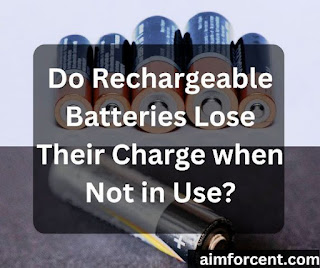Why can Rechargeable Batteries Not be Recharged Forever?
Many customers prefer rechargeable batteries because of their cost-effectiveness. Is it really better than regular batteries? Yes, rechargeable batteries offer many facilities that regular batteries cannot offer! One such feature is multiple recharge cycles. Indeed, there is a limitation; too, I am going to cover this today.
Learn the Chemistry behind Rechargeable Batteries
To understand why rechargeable batteries cannot be recharged forever, you need to understand the chemistry behind rechargeable batteries. However, it is not a simple process, so read it twice to understand.
- Rechargeable batteries come with electrochemical cells, which convert chemical energy into electrical energy.
- In a rechargeable battery, the electrochemical cells contain two electrodes, an anode, and a cathode, which are separated by an electrolyte.
- During the charging process, ions move from the cathode to the anode, where they are stored as potential energy.
- During discharge, the process is reversed, and the stored energy is converted back into electrical energy.
- However, this process is not 100% efficient, and some of the ions become trapped in the anode or cathode, reducing the battery’s capacity and overall performance over time.
How Do the Effects of Cycling Impact the Rechargeable Battery Performance?
Many experts share different views regarding this subject, but I feel the effects of cycling are one of the primary reasons.
Let’s understand the concept:
First, what is cycling?
Cycling refers to the process of charging and discharging a battery, and each cycle can cause damage to the battery’s chemistry and structure.
During each cycle, the battery’s electrodes experience stress due to ions movement, and over time it causes structural damage to the electrodes. As a result, the battery’s capacity starts to deteriorate. Moreover, it also leads to the formation of metal deposits on the battery’s electrodes, which reduces the battery’s performance.
How Does the Self-Discharge Rate Affect the Rechargeable Battery Capacity?
Another factor that limits the lifespan of rechargeable batteries is self-discharge. It refers to the rate at which a battery loses its charge over time, even when not used.
It is true that all batteries (even branded batteries, too!) experience some degree of self-discharge, and the rate of self-discharge depends on the battery’s chemistry and other factors. Over time it reduces the battery capacity and overall performance.
How Does Temperature Affect Battery Performance?
Heat is another factor that can significantly impact the lifespan of rechargeable batteries. High temperatures break the battery’s chemistry, leading to a decrease in performance.
That is why I always prefer to recharge and store rechargeable batteries at room temperature and avoid exposing them to extreme heat. You can find the manufacturer’s guidance to ‘keep it in a cool and dry place.’
Do Overcharging and Over-Discharging Deteriorate the Battery Performance?
Overcharging and over-discharging are two other factors that also deteriorate the battery performance, but it impacts more non-branded batteries.
Overcharging refers to the process of continuing to charge a battery after it has reached its full charge capacity.
Over-discharging refers to the process of discharging a battery to the point where its voltage drops below a safe level.
Both of these processes can cause damage to a battery’s chemistry and structure, reducing its overall lifespan and performance.
In this post, you have learned four reasons why rechargeable batteries cannot be recharged forever. Do you think I have missed any important points? Have any queries? Please feel free to comment below.
Want to learn more about rechargeable batteries? Find other interesting posts:
How Many Hours Do Rechargeable Batteries Last Per Charge?
How Long Does It Take to Charge a 1500 mAh Battery?
Meet Rohan, a writer who loves to inspire and motivate others. He’s all about those feel-good quotes that can light up your day! When he’s not crafting words of encouragement, Rohan dives into the world of the latest technologies, exploring what’s new and exciting. But that’s not all—his heart beats for solar products, the kind that harness the power of the sun for a greener future. And guess what? He’s a total pet lover too! When he’s not busy writing, you’ll find Rohan surrounded by his furry friends, spreading joy and cuddles all around. Follow Rohan on Twitter and Facebook







